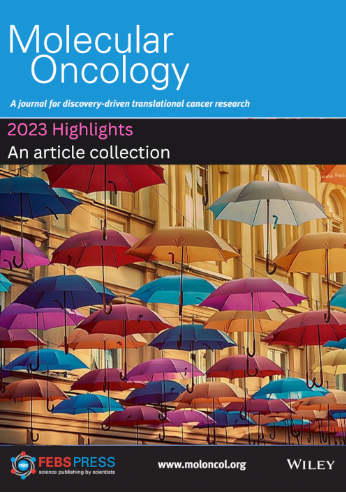MSP - RON轴刺激三阴性乳腺癌模型中的癌细胞生长
IF 5
2区 医学
Q1 ONCOLOGY
引用次数: 9
摘要
三阴性乳腺癌癌症是癌症最具侵袭性的亚型,预后不良,复发率高。TNBC缺乏可操作的靶点导致了这种疾病的高死亡率,迫切需要用于潜在操作的新的候选分子。在此,我们表明,在Trp53和Brca1缺失驱动的TNBC小鼠模型中,巨噬细胞刺激蛋白(MSP)及其酪氨酸激酶受体RON是癌症细胞生长和肿瘤进展的有力驱动因素。通过对两种TNBC基因工程小鼠模型的比较,我们发现K14-Cre的乳腺肿瘤;Brca1F/F;Trp53F/F(KB1P)小鼠表现出高的内源性MSP和RON表达水平。我们发现MSP刺激KB1P细胞系中的AKT和ERK1/2活化以及癌症细胞生长,而RON的遗传和药理学抑制可阻止这些作用。类似地,通过用RON抑制剂治疗,伴随着增殖标记物Ki-67的减少,小鼠的KB1P肿瘤进展被有力地减弱。我们在MSP和RON表达自然增加的小鼠模型中的发现提供了证据,证明该受体及其配体是靶向治疗TNBC的可行候选分子。本文章由计算机程序翻译,如有差异,请以英文原文为准。
The MSP‐RON axis stimulates cancer cell growth in models of triple negative breast cancer
Triple negative breast cancer is the most aggressive subtype of breast cancer with poor prognosis and high rates of relapse. The lack of actionable targets for TNBC has contributed to the high mortality rates of this disease, and new candidate molecules for potential manipulation are urgently required. Here, we show that macrophage-stimulating protein (MSP) and its tyrosine kinase receptor, RON, are potent drivers of cancer cell growth and tumor progression in a mouse model of TNBC driven by the loss of Trp53 and Brca1. After comparison of two genetically engineered mouse models of TNBC, we found that mammary tumors from K14-Cre;Brca1F/F;Trp53F/F (KB1P) mice exhibit high endogenous levels of MSP and RON expression. We show that MSP stimulates AKT and ERK1/2 activation as well as cancer cell growth in KB1P cell lines, while genetic and pharmacological inhibition of RON prevents these effects. Similarly, KB1P tumor progression in mice was robustly attenuated by treatment with a RON inhibitor with accompanied reduction in the proliferation marker, Ki-67. Our findings in a mouse model where MSP and RON expression are naturally increased provide evidence that this receptor and its ligand are viable candidate molecules for targeted treatment of TNBC.
求助全文
通过发布文献求助,成功后即可免费获取论文全文。
去求助
来源期刊

Molecular Oncology
医学-肿瘤学
CiteScore
12.60
自引率
1.50%
发文量
203
审稿时长
6-12 weeks
期刊介绍:
Molecular Oncology highlights new discoveries, approaches, and technical developments, in basic, clinical and discovery-driven translational cancer research. It publishes research articles, reviews (by invitation only), and timely science policy articles.
The journal is now fully Open Access with all articles published over the past 10 years freely available.
 求助内容:
求助内容: 应助结果提醒方式:
应助结果提醒方式:


